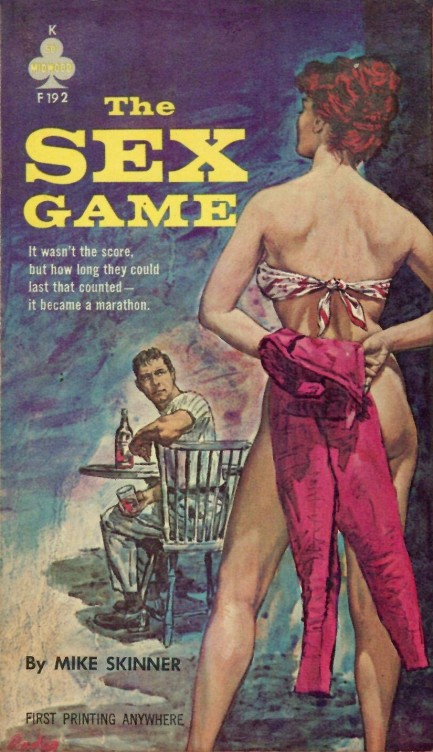 It's a score sheet. I didn't tell you in advance because I didn't want you to get nervous. But I guess you did anyway. 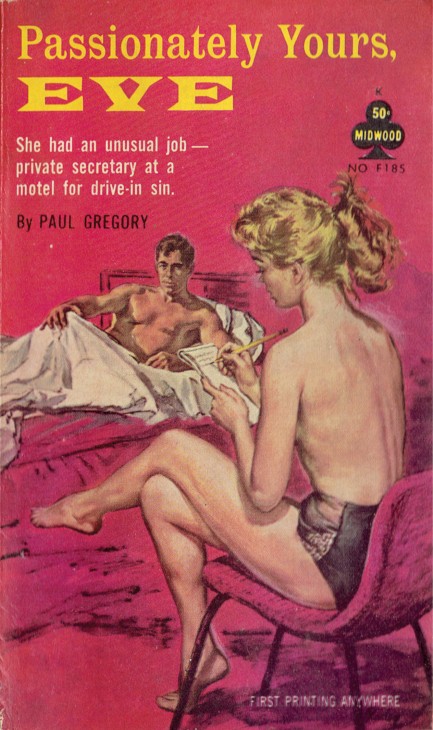
Above: one of our regular check-ins with paperback illustrator Paul Rader, whose work is always excellent. In addition to being adept, his pieces are usually humorous. See some good examples here, here, here, here, and here.
 You know, fabric uses up an awful lot of paint. Why don't you ditch the wrap and we'll just make this a nude. 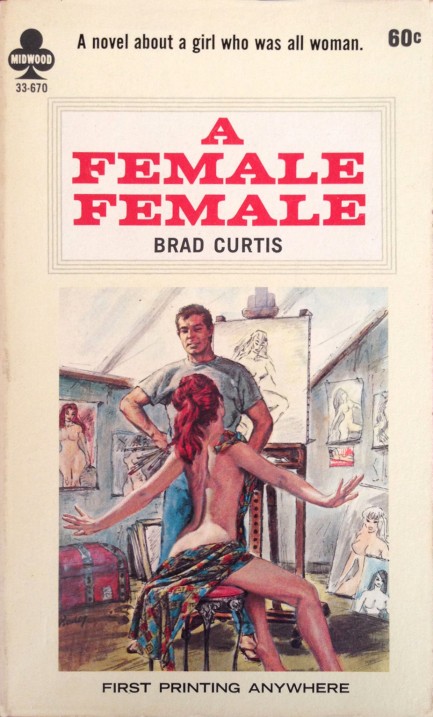 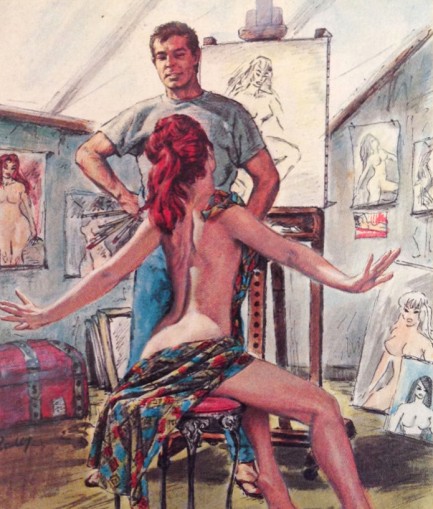
Here's another addition to our collection of covers with artists and models. We've also shared a few strays that use the same theme, such as here. A Female Female by Brad Curtis deals with the adventures of a first-time artist's model named Bee who crosses the line between nude modeling as a professional versus sexual activity. We last saw Curtis years ago when we shared a cover for his 1963 novel Man Trap. Both that one and the one above were painted by the prolific Paul Rader, who we've seen a lot of and will see again.
 Hi. Becky said it would be okay if I slept over. She didn't specify in whose bedroom. 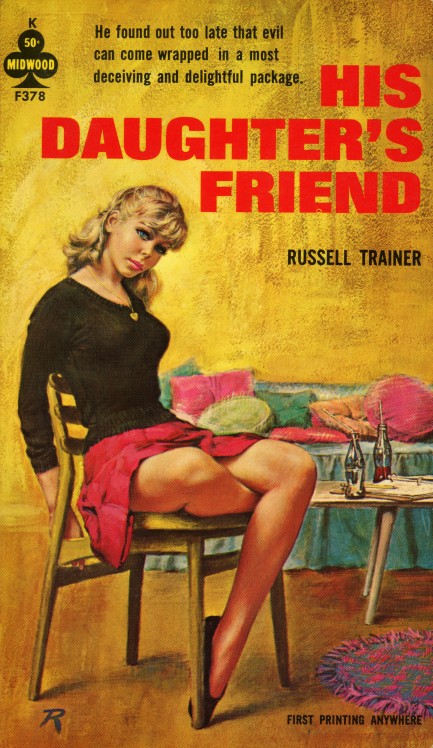
Above: the immediately identifiable work of the great Paul Rader fronting Russell Trainer's His Daughter's Friend. This is about a widower who gets into deep, deep trouble with a predatory teen. It came in 1964, after another book along the same lines, Wade Miller's famed Kitten with a Whip. Neither were among the first novels of their type. We'd guess the basic idea of adult-and-teen disaster goes back to the beginning of commercial publishing. The few we've read—aside from Lolita—feature girls above the age of consent back in 1964, and we bet that's the case here too. Those who don't read vintage books might suspect that such behavior is condoned, but it isn't—the entire point of these tales is that the men throw away or almost throw away everything, including their jobs, families, and freedom. We won't know exactly what His Daughter's Friend is about until we buy it, which we'll do, but not at two-hundred-plus dollars. That's the ask at the moment, and it's way too high. But someone will put it online at a reasonable price eventually. They almost always do.
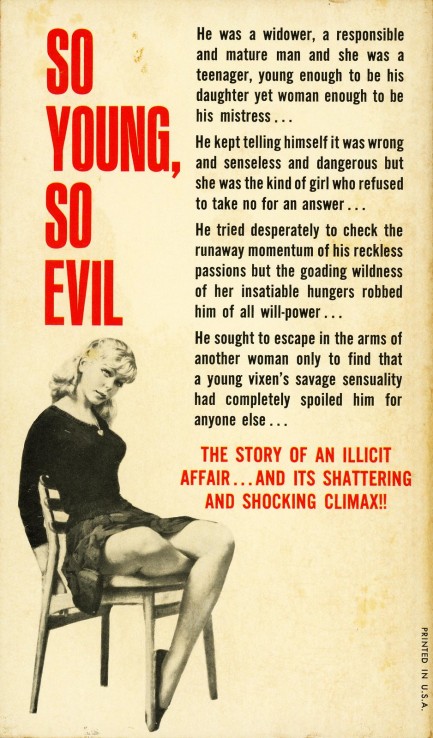
 Well, sure, honey, if that's what you want, I guess I can try to help you put this deal to bed. 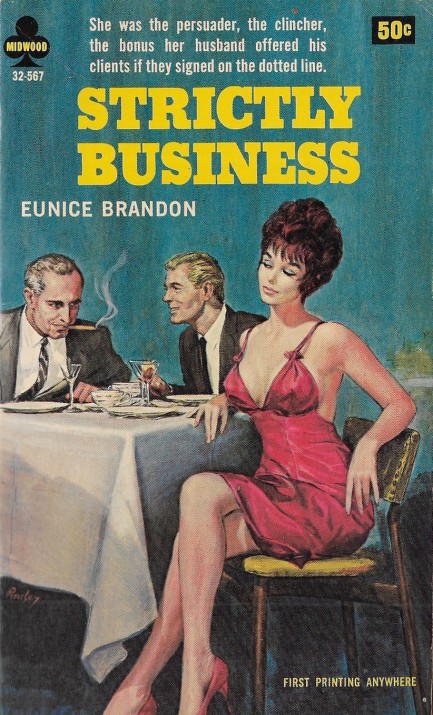
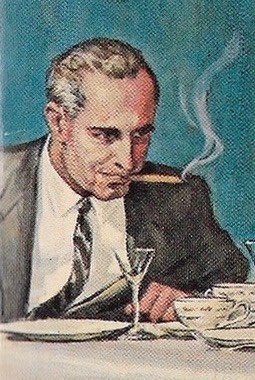 Midwood Books had a near-monopoly on artist Paul Rader, and good thing, because the guy was brilliant. His cover for the sleaze novel Strictly Business features an amusing tableau of a dapper businessman chatting with his leering colleague, as a coy beauty sits nearby. Midwood Books had a near-monopoly on artist Paul Rader, and good thing, because the guy was brilliant. His cover for the sleaze novel Strictly Business features an amusing tableau of a dapper businessman chatting with his leering colleague, as a coy beauty sits nearby.
The cover blurb is a little deceptive. The husband in this tale is actually the first to cheat, which drives his wife to do the same, first sampling some same-sex sweetness, then bedding down with her hubbie's hated rival. While the husband has an affair to help his business, his wife cheats in retaliation. When the husband encourages her to use her wiles to help him seal a deal, she leaves him. End of book. So the cover text is not on target. Not only that, but the rear synopsis makes up a scenario that never occurs at any point. Such are the hazards of sleaze novels, but this one is still a pretty fun read. Midwood was top of the genre for good reason.
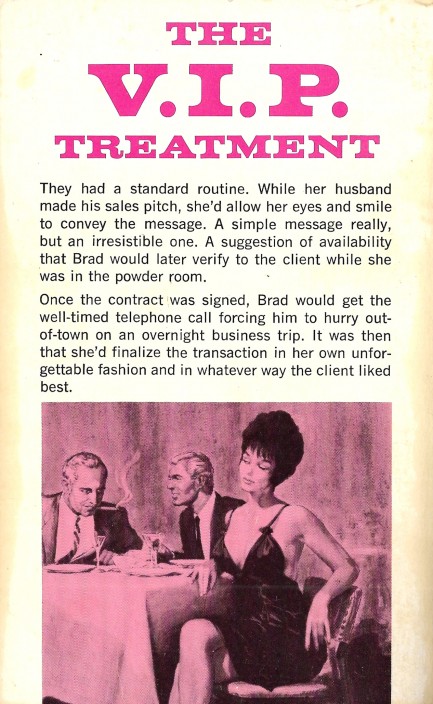
 And end with, “Therefore, honey, I've left you for my secretary.” Drop that in the mail room, then confirm our flight to Bimini. 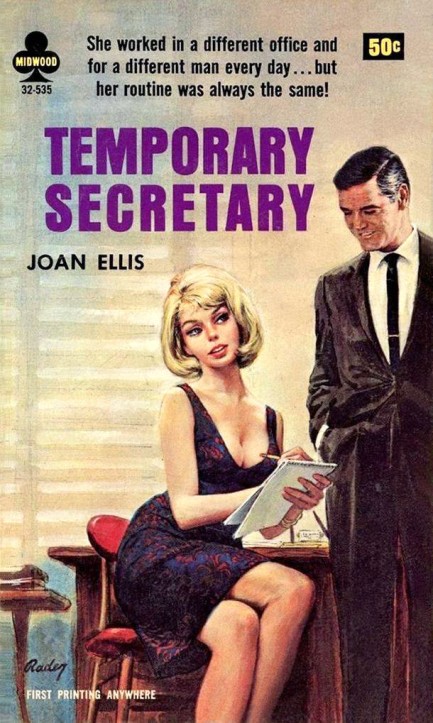
In mid-century sleaze novels every working woman is a bombshell and every employer is tall, dapper, and virile. Paul Rader hits both notes on this cover for Temporary Secretary by Joan Ellis. Rader was an amazing illustrator. The key to this effort is in the angle of the male figure's head. There's no doubt he's aiming his gaze not at the secretary's shorthand pad, but a few degrees to its right. Very well done, copyright 1965.
 Alright, who do I have to lure to my hotel room and get photographed in a compromising position to win this thing? 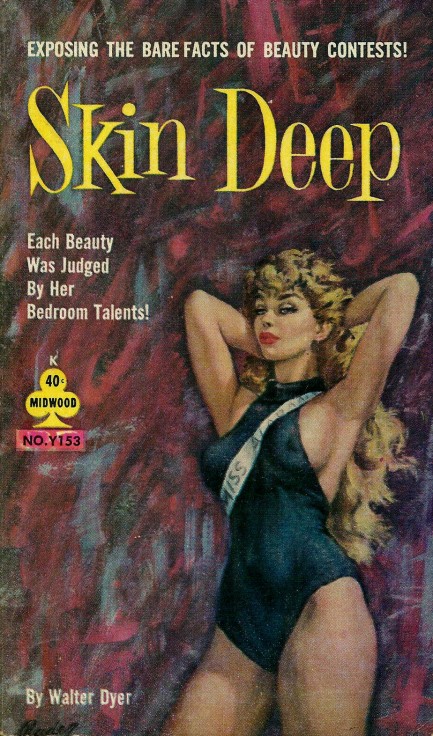
Her sash says Miss Alabama, but since she fronts a Midwood sleaze paperback we're crowning her Miss Midwood Sleaze 1962. The cover was painted by Paul Rader and the rear text explains all you need to know about Walter Dyer's tale: This book tells you how beauty contests are judged and about the love-ripened contestants who will go to any lengths to win! It definitely sounds like a fertile milieu for a sleaze novel, and got us thinking about our favorite beauty contest winners. Lynda Carter comes to mind. Candice Bergen. Lee Meriwether. Isabel Sarli. Sophia Loren competed but didn't win, amazingly. Here's someone else who competed and didn't win, but we love her. Who else is there? Vanessa Williams. Love her too, though not for her pageant work. Hah. Same with Isabelle Chaudieu. Maybe we can put together a post of vintage stars who competed in beauty contests. That might be fun. Top of the list: Sean Connery, aspiring Mr. Universe of 1953. 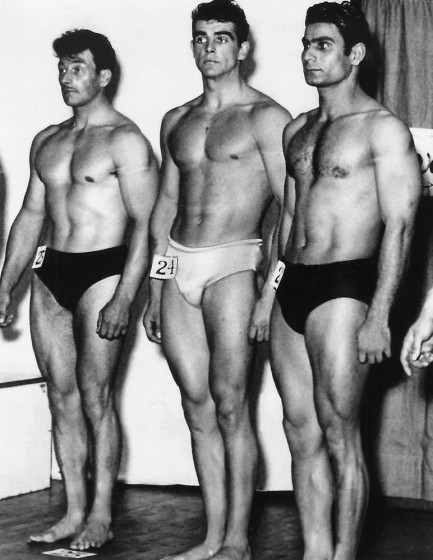
 Since you're supposed to be so good at reading signs, what am I asking for right now? 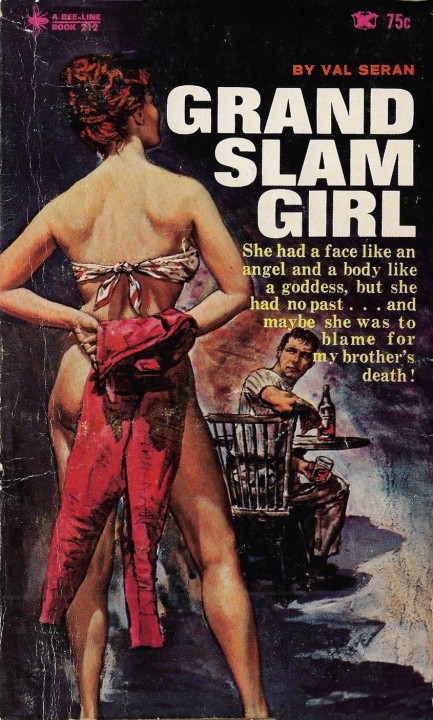
Val Seran's 1967 novel Grand Slam Girl took us by surprise by being a sleaze novel. The rear cover text suggested a crime thriller set in the world of baseball, and it's that, but it's also an erotic novel littered with a dozen or so semi-explicit lovemaking scenes. Such scenes are fun when they're well written. Here they aren't, and an additional problem is that there are almost as many rapes as sex scenes, as a quartet of organized crime thugs use sexual assault as their go-to weapon. The thriller aspect of the story deals with a minor league pitcher named Jack Sweet who gets involved with the fiancée of his murdered brother. Did she kill him? We didn't care, and we weren't intrigued by the book's heroin smuggling subplot either. Somehow Seran, aka Curt Allen, managed to publish at least ten books. Based on this effort we find that surprising. Edit: We've just learned that the cover, uncredited by Bee-Line Books, is repurposed Paul Rader art from the 1962 Midwood Books sleazer The Sex Game, written by Mike Skinner.
 When you think about the enormity of the sky and the vastness of nature doesn't it make taking off your blouse seem insignificant? 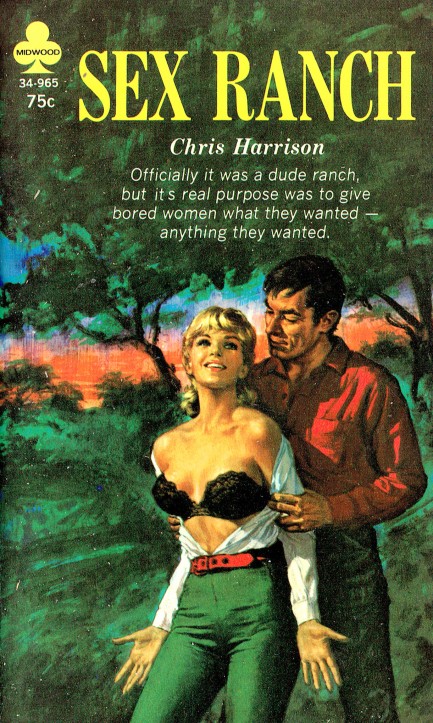
Above, a cover for Chris Harrison's sleaze novel Sex Ranch, published by Midwood Books in 1968, the last year the company was active. The art is unsigned but it's the work of the masterful Paul Rader, who we just saw yesterday. But we brought him back because he's one of our favorites. Hell, he's a favorite of anyone who follows vintage paperback art. Not only is he a top notch illustrator, but his work has given us many opportunities for enjoyable riffing. You can find some amusing efforts here, here, here, and here.
 Whatever floats your corpse. 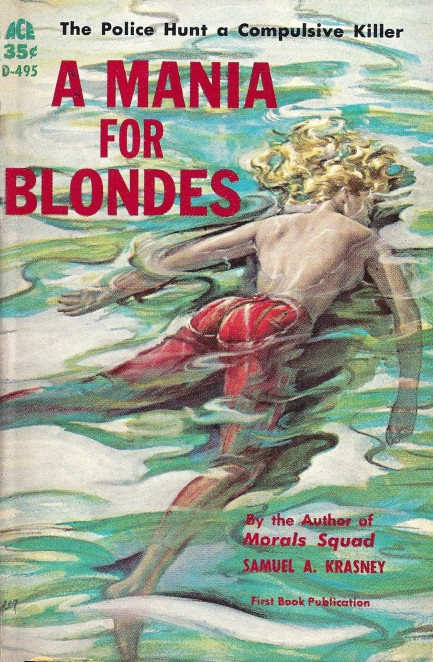
Art by Paul Rader fronts this copy of Samuel A. Krasney's A Mania for Blondes, a police proceedural dealing with two women drowned in Philadelphia's Delaware River, and the investigation to bring a killer to justice. The protagonist here is vice detective Ben Krahmer, who learns that both victims appeared in nudie reels. The clues lead down the rabbit hole of illicit porn and toward a mysterious suspect witnesses think looks like Zorro—but who Krahmer soon realizes may be a member of Pennsylvania's traditionally garbed Dutch community. Procedurals sometimes—as is the case here—fail to provide deep characterizations, but the mechanics of the investigation are interesting. Krasney constantly refers to his protagonist as “the Morals man”—capital M—which we found weird, but we thought this outing was solid overall and we liked the Zorro imagery. Even so, we probably won't go looking for more from Krasney unless we run across him cheap. There are, after all, so many paperbacks, and so little time.
 Well fine. If you really want to know, in my experience, you're very much on the smaller side. 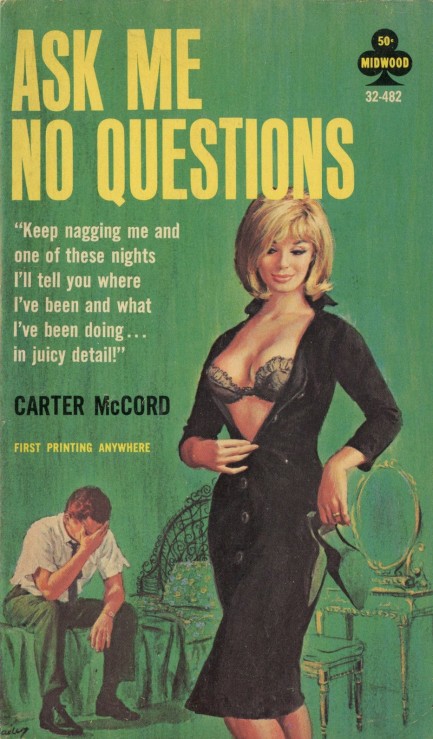
Above: the 1965 sleaze novel Ask Me No Questions by Carter McCord, with cover art by Paul Rader. Be careful what you ask. If you aren't—just look at the poor guy in the background—you could end up like him.

|
 |

The headlines that mattered yesteryear.
2003—Hope Dies
Film legend Bob Hope dies of pneumonia two months after celebrating his 100th birthday. 1945—Churchill Given the Sack
In spite of admiring Winston Churchill as a great wartime leader, Britons elect
Clement Attlee the nation's new prime minister in a sweeping victory for the Labour Party over the Conservatives. 1952—Evita Peron Dies
Eva Duarte de Peron, aka Evita, wife of the president of the Argentine Republic, dies from cancer at age 33. Evita had brought the working classes into a position of political power never witnessed before, but was hated by the nation's powerful military class. She is lain to rest in Milan, Italy in a secret grave under a nun's name, but is eventually returned to Argentina for reburial beside her husband in 1974. 1943—Mussolini Calls It Quits
Italian dictator Benito Mussolini steps down as head of the armed forces and the government. It soon becomes clear that Il Duce did not relinquish power voluntarily, but was forced to resign after former Fascist colleagues turned against him. He is later installed by Germany as leader of the Italian Social Republic in the north of the country, but is killed by partisans in 1945.
|

|
|

It's easy. We have an uploader that makes it a snap. Use it to submit your art, text, header, and subhead. Your post can be funny, serious, or anything in between, as long as it's vintage pulp. You'll get a byline and experience the fleeting pride of free authorship. We'll edit your post for typos, but the rest is up to you. Click here to give us your best shot.

|
|










 Midwood Books had a near-monopoly on artist Paul Rader, and good thing, because the guy was brilliant. His cover for the sleaze novel Strictly Business features an amusing tableau of a dapper businessman chatting with his leering colleague, as a coy beauty sits nearby.
Midwood Books had a near-monopoly on artist Paul Rader, and good thing, because the guy was brilliant. His cover for the sleaze novel Strictly Business features an amusing tableau of a dapper businessman chatting with his leering colleague, as a coy beauty sits nearby.







